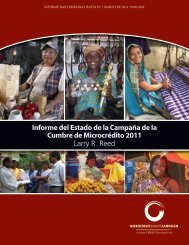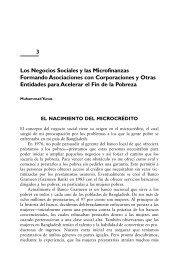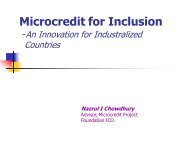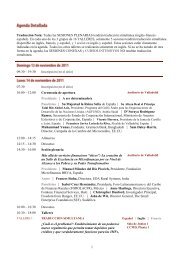Integrating Microfinance and Health - Global Microcredit Summit 2011
Integrating Microfinance and Health - Global Microcredit Summit 2011
Integrating Microfinance and Health - Global Microcredit Summit 2011
Create successful ePaper yourself
Turn your PDF publications into a flip-book with our unique Google optimized e-Paper software.
exp<strong>and</strong>s <strong>and</strong> assists development organizations in other countries, such as Afghanistan, Pakistan,Ug<strong>and</strong>a, Tanzania, Liberia, Sierra Leone, Southern Sudan <strong>and</strong> Haiti.<strong>Health</strong> services include education, community health promotion using trained communityvolunteers ,who also provide access to health products, <strong>and</strong> programs directed at specificdiseases <strong>and</strong> health problems such as tuberculosis <strong>and</strong> malaria, maternal, neonatal <strong>and</strong> childhealth, <strong>and</strong> the reduction of cataract-related blindness. BRAC owns <strong>and</strong> operates health facilities<strong>and</strong> a limb <strong>and</strong> brace center. At the end of 2010, BRAC reported that it was reaching over 100million people with a wide range of health services. 1 One of the most important components ofmany of BRAC’s health programs is the use of trained community volunteers called shasthoshebikas (SS) who provide health outreach <strong>and</strong> health product distribution. Some of the SSreceive more specialized training equipping them to work with the DOTS program as screeners<strong>and</strong> distributors of reading glasses.BRAC has a large in-house research capacity <strong>and</strong> evaluates its programs for their responsivenessto client needs, quality of services provided, <strong>and</strong> to measure <strong>and</strong> document the impact of itshealth interventions on client <strong>and</strong> community health status. BRAC routinely collects informationabout progress towards key health indicators to ensure quality <strong>and</strong> to continuously improve thequality <strong>and</strong> effectiveness of its services. Its research <strong>and</strong> monitoring have shown the following 2 :In 2002, 33 percent of pregnant women surveyed in BRAC’s village organizations hadreceived antenatal care <strong>and</strong> by 2007, the figure had risen to 72 percent, as compared to 60percent nationally. Studies in 2007 indicated that 96 percent of children were fully immunized (versus 86percent nationally) <strong>and</strong> 62 percent of women were currently using contraceptives (versus 56percent nationally).1 BRAC Annual Report 2010. BRAC: Dhaka, Bangladesh. http://www.brac.net/sites/default/files/BRAC-Annual-Report-2010.pdf2 Salam S, Khan M, Salahuddin S, Choudhury N, Nicholls P, Nasreen H. Maternal, neonatal <strong>and</strong> child health inselected northern districts of Bangladesh: Findings from baseline survey. BRAC: Bangladesh. 2008; Choudury N<strong>and</strong> Nasreen H. Newborn care practices in Nilphamari district of Bangladesh after a year of maternal, neonatal <strong>and</strong>child health intervention. December 2009.39












